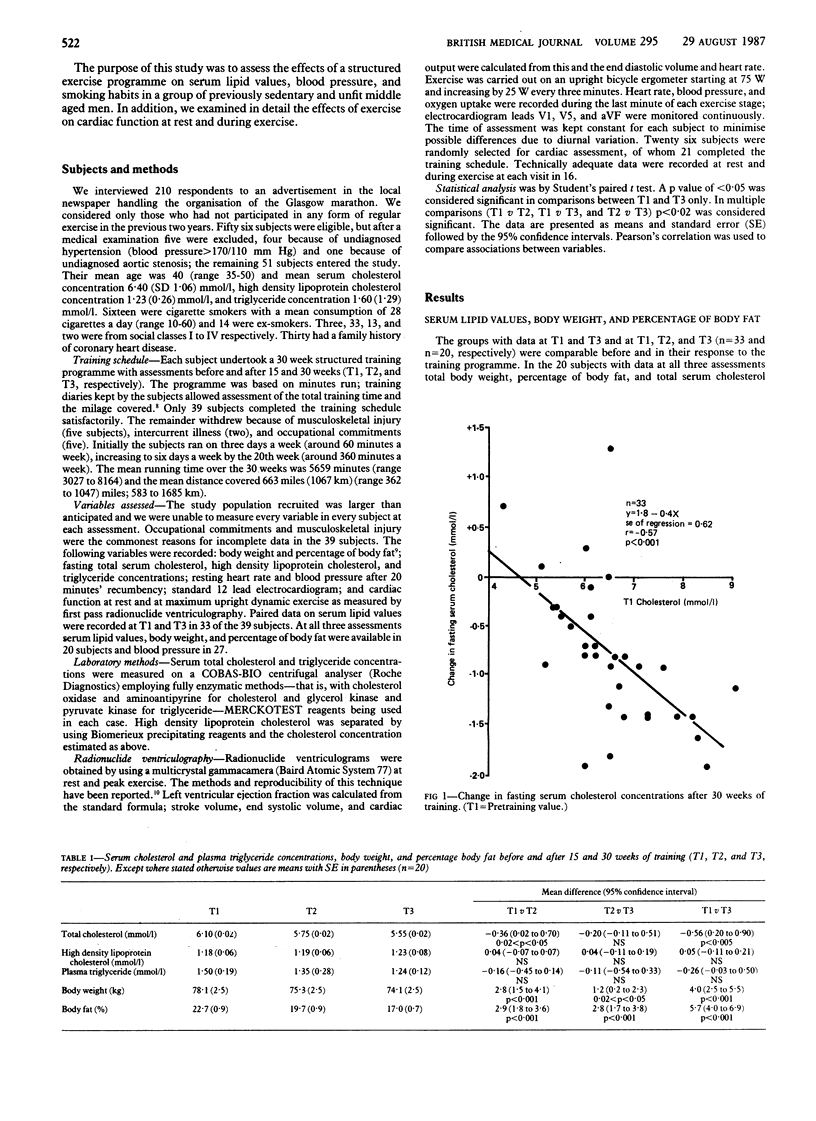Abstract
The effects of a 30 week exercise programme on serum lipid values, blood pressure, and cardiac function were assessed in a group of sedentary men aged 35-50 training for their first marathon. Mean serum cholesterol concentration (n = 33) fell by 12% from 6.54 (SE 0.18) to 5.76 (0.15) mmol/l (mean fall 0.78 mmol/l; 95% confidence interval 0.52 to 1.04 mmol/l), serum triglyceride concentration (n = 33) by 22% from 1.56 (0.17) to 1.21 (0.09) mmol/l (mean fall 0.34 mmol/l; 95% confidence interval 0.12 to 0.56 mmol/l), and mean blood pressure (n = 27) by 10% from 102 (2) to 92 (2) mm Hg (mean fall 10 mm Hg; 95% confidence interval 7 to 13 mm Hg). These changes were not explained by changes in body composition. Peak exercise left ventricular end diastolic volume (n = 16) increased with training; as a result of this and an increased exercise left ventricular ejection fraction peak exercise cardiac output increased from 19.9 (1.2) to 23.1 (3.0) l/min (mean rise 3.2 l/min; 95% confidence interval 1.5 to 5.0 l/min). Maximum oxygen consumption increased from 33.9 (1.6) to 39.0 (1.3) ml/kg/min (mean rise 5.0 ml/kg/min; 95% confidence interval 1.8 to 8.2 ml/kg/min). This study showed favourable effects on coronary risk factors and cardiac function and supports the place of regular exercise in coronary prevention programmes.
Full text
PDF



Selected References
These references are in PubMed. This may not be the complete list of references from this article.
- Bonanno J. A., Lies J. E. Effects of physical training on coronary risk factors. Am J Cardiol. 1974 May 20;33(6):760–764. doi: 10.1016/0002-9149(74)90218-5. [DOI] [PubMed] [Google Scholar]
- Cleland J. G., Dargie H. J., Findlay I. N., Wilson J. T. Clinical, haemodynamic, and antiarrhythmic effects of long term treatment with amiodarone of patients in heart failure. Br Heart J. 1987 May;57(5):436–445. doi: 10.1136/hrt.57.5.436. [DOI] [PMC free article] [PubMed] [Google Scholar]
- Dehmer G. J., Lewis S. E., Hillis L. D., Corbett J., Parkey R. W., Willerson J. T. Exercise-induced alterations in left ventricular volumes and the pressure-volume relationship: a sensitive indicator of left ventricular dysfunction in patients with coronary artery disease. Circulation. 1981 May;63(5):1008–1018. doi: 10.1161/01.cir.63.5.1008. [DOI] [PubMed] [Google Scholar]
- Ehsani A. A., Heath G. W., Hagberg J. M., Sobel B. E., Holloszy J. O. Effects of 12 months of intense exercise training on ischemic ST-segment depression in patients with coronary artery disease. Circulation. 1981 Dec;64(6):1116–1124. doi: 10.1161/01.cir.64.6.1116. [DOI] [PubMed] [Google Scholar]
- Goldberg L., Elliot D. L. The effect of physical activity on lipid and lipoprotein levels. Med Clin North Am. 1985 Jan;69(1):41–55. [PubMed] [Google Scholar]
- Hartung G. H., Foreyt J. P., Mitchell R. E., Vlasek I., Gotto A. M., Jr Relation of diet to high-density-lipoprotein cholesterol in middle-aged marathon runners, joggers, and inactive men. N Engl J Med. 1980 Feb 14;302(7):357–361. doi: 10.1056/NEJM198002143020701. [DOI] [PubMed] [Google Scholar]
- Hovell M. F. The experimental evidence for weight-loss treatment of essential hypertension: a critical review. Am J Public Health. 1982 Apr;72(4):359–368. doi: 10.2105/ajph.72.4.359. [DOI] [PMC free article] [PubMed] [Google Scholar]
- Jung R. T., Shetty P. S., Barrand M., Callingham B. A., James W. P. Role of catecholamines in hypotensive response to dieting. Br Med J. 1979 Jan 6;1(6155):12–13. doi: 10.1136/bmj.1.6155.12. [DOI] [PMC free article] [PubMed] [Google Scholar]
- Martin R. P., Haskell W. L., Wood P. D. Blood chemistry and lipid profiles of elite distance runners. Ann N Y Acad Sci. 1977;301:346–360. doi: 10.1111/j.1749-6632.1977.tb38212.x. [DOI] [PubMed] [Google Scholar]
- Nelson L., Jennings G. L., Esler M. D., Korner P. I. Effect of changing levels of physical activity on blood-pressure and haemodynamics in essential hypertension. Lancet. 1986 Aug 30;2(8505):473–476. doi: 10.1016/s0140-6736(86)90354-5. [DOI] [PubMed] [Google Scholar]
- Redwood D. R., Rosing D. R., Epstein S. E. Circulatory and symptomatic effects of physical training in patients with coronary-artery disease and angina pectoris. N Engl J Med. 1972 May 4;286(18):959–965. doi: 10.1056/NEJM197205042861801. [DOI] [PubMed] [Google Scholar]
- Román O., Camuzzi A. L., Villalón E., Klenner C. Physical training program in arterial hypertension. A long-term prospective follow-up. Cardiology. 1981;67(4):230–243. doi: 10.1159/000173248. [DOI] [PubMed] [Google Scholar]
- Seals D. R., Hagberg J. M. The effect of exercise training on human hypertension: a review. Med Sci Sports Exerc. 1984 Jun;16(3):207–215. [PubMed] [Google Scholar]
- Shephard R. J. Exercise in coronary heart disease. Sports Med. 1986 Jan-Feb;3(1):26–49. doi: 10.2165/00007256-198603010-00004. [DOI] [PubMed] [Google Scholar]


